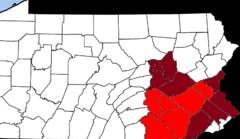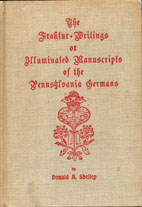The first step to understanding fraktur is to look carefully at a few specimens and note what you see. Generally, the text of the piece is central to the composition and is surrounded by ornamental embellishment. Further, the text is of a distinctive style, marked by angularity and obviously of the “gothic” family. The overall appearance is that of folk art. The language is German.
Folk life scholar Don Yoder confirms and explicates these observations. He defines fraktur as “the manuscript art of the Pennsylvania Germans.” Manuscript art connotes the decoration of paper with calligraphic texts and related designs, figures, and symbols (Yoder, 1974). The two essential elements are “a text done in Fraktur lettering and designs surrounding or embellishing the text” (Yoder, A fraktur primer, 1989).
 The Pennsylvania German settlement centers on the broad semi-circle around Philadelphia with Bucks and Northumberland counties in the east, York in the west, Lancaster in the south and Northumberland in the north (Swank, viii). Numerous other states and Canadian provinces experienced “Pennsylvania German” influence during and after the principal period of migration, 1683 to about 1820. The folk culture established by this group, of which fraktur is but one part, flourished from about 1750 through 1840 (Swank, p. 4). This period roughly corresponds with the golden age of folk art among numerous ethnicities in the United States, Canada and Europe.
The Pennsylvania German settlement centers on the broad semi-circle around Philadelphia with Bucks and Northumberland counties in the east, York in the west, Lancaster in the south and Northumberland in the north (Swank, viii). Numerous other states and Canadian provinces experienced “Pennsylvania German” influence during and after the principal period of migration, 1683 to about 1820. The folk culture established by this group, of which fraktur is but one part, flourished from about 1750 through 1840 (Swank, p. 4). This period roughly corresponds with the golden age of folk art among numerous ethnicities in the United States, Canada and Europe.
 The name fraktur came to mean the folk art form as well as the letter style that is central to it. Pennsylvania Germans brought the use of fraktur on formal documents with them to the New World. The fraktur face was developed in the early sixteenth century and became dominant in northern Germany while Schwabacher grew in popularity in South Germany. Together with Textura, the “gothic” style of newspaper headlines, these are among the most popular black letter forms.
The name fraktur came to mean the folk art form as well as the letter style that is central to it. Pennsylvania Germans brought the use of fraktur on formal documents with them to the New World. The fraktur face was developed in the early sixteenth century and became dominant in northern Germany while Schwabacher grew in popularity in South Germany. Together with Textura, the “gothic” style of newspaper headlines, these are among the most popular black letter forms.
The name “fraktur” derives from its angular, fractured appearance. As Dr. Shelley points out, the fraktur face was familiar to Pennsylvania German settlers through written and engraved copybooks, letters of apprenticeship, deeds and official edicts in Europe. He characterizes the accompanying decorations as akin to the somewhat Oriental motifs of eighteenth century European hand-blocked and woven textile design – a possible source (Shelley, 1961, p. 22).
Fraktur as a folk art is found in numerous varieties. Another eminent scholar of the field, Donald Shelley, lists eight types, which Pastor Frederick Weiser identifies as the “Mercer/Borneman” manner of classification, after two earlier researchers (Weiser, Piety and protocol, 1973, p. 19). The eight types (plus “miscellaneous”) are:
- Taufscheine or birth and Baptismal certificates
- Vorschriften or writing specimens
- Religious broadsides, including
Goldene ABC, Geistliche Irrgarten, 7 rules, spirals and circles, Haus-Segens, geistlicher Uhrwerken - Illuminated books and bookplates
- Bookmarks, rewards of merit and small design pieces
- Love letters, true-lovers’ knots, valentines, ample grove designs
- Pictorial fraktur designs and drawings
- Miscellaneous fraktur
(Shelley, 1961, p. 40 – 58).
 Working from the art-historical perspective that is his strength, Dr. Shelley also identifies stylistic schools of the fraktur art form, which overlap the types listed above:
Working from the art-historical perspective that is his strength, Dr. Shelley also identifies stylistic schools of the fraktur art form, which overlap the types listed above:
- Ephrata School (1745 – 1755)
- Mennonite School (1760-1856)
- Schwenkfelder School (1769 – 1854)
- Written Taufscheins and writers
- Printed Taufscheins
- Miscellaneous fraktur
(Shelley, 1961, p. 101 +).
As Pastor Weiser concludes, “the Mercer-Borneman classification has greater utility when fraktur writings are studied from a cultural history point of view. Shelley’s is useful if one is interested in artistic analysis” (Weiser, Piety and protocol, 1973, p. 19).
We are advantaged by advanced scholarship of fraktur by authors such as Russell and Corrine Earnest, Dennis Moyer, Dr. Donald Shelley, Pastor Frederick Weiser, Dr. Don Yoder and others. I hope readers will be motivated to find and read their works, listed in the accompanying bibliography and Top Ten books. I also hope readers will perceive the beauty and experience the special message of this folk art for themselves.